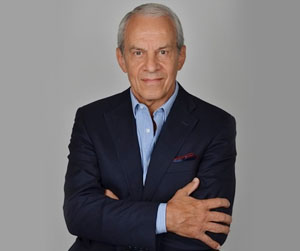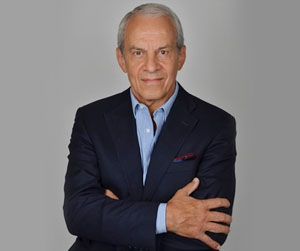The facial minilift
The Minilift (Soft Lift, French Touch, Macs Lift, Natural Lift, ...) is a quick and simple operation, much lighter than a standard facelift, which affects the whole face. It gives a toned appearance to a face that has sagged in the areas usually most affected by aging: the cheeks, jowls, the bitterness fold, the cheekbones, the oval of the face and the neck.
It does not change the expression at all, an important element in your facial identity. On the contrary, it allows the face to have a natural expression and tone by preventing the slackening of the lower face and neck. This is achieved through a quick operation (1hour), which can be performed under local anaesthetic for those who prefer this. Time out from social activities is needed for few days and there is a small, very discreet scar, hidden under the sideburn and by the contour of the ear.
The goal is for those around you to notice a change and an improvement and to think that you look well, but without necessarily being able to see that you have had an operation.
If you are also bothered by your eyelids, you can combine eyelid plastic surgery with a Minilift for a harmonious result.
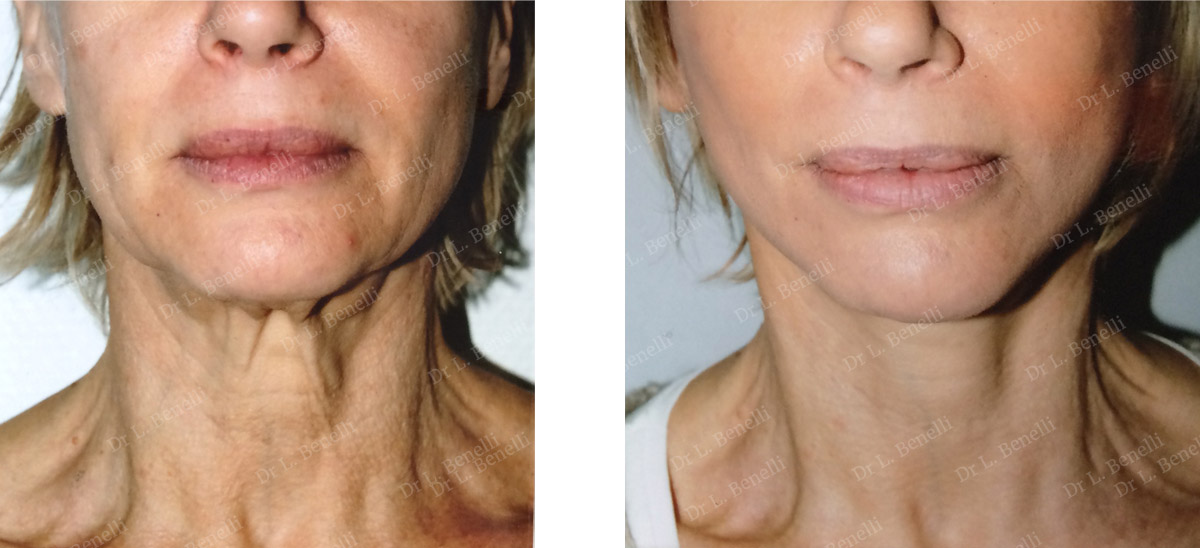
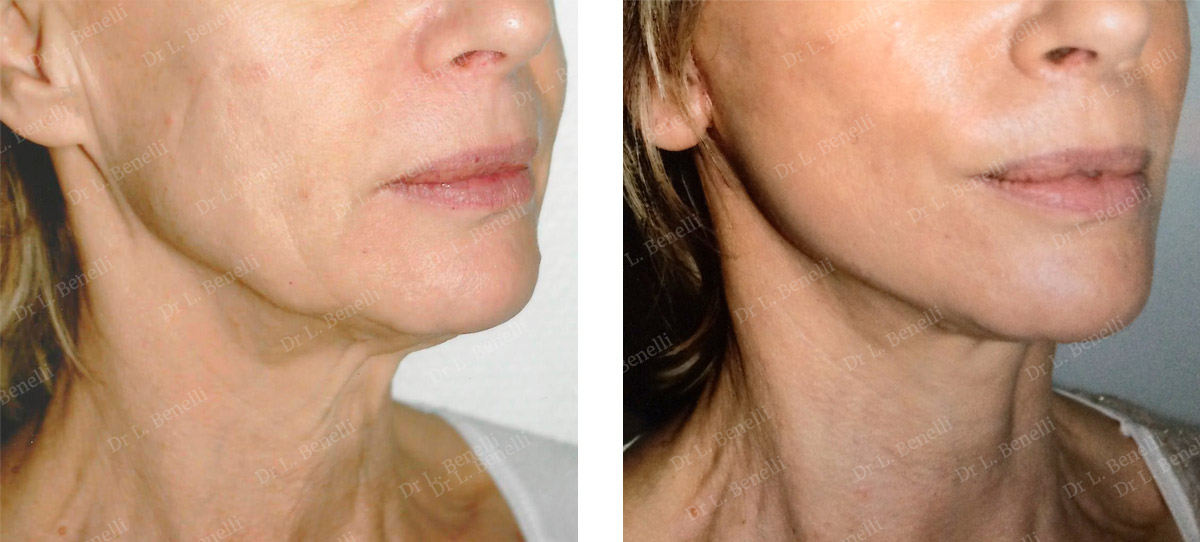
Minilift. Results after 3 days. The postoperative effects of a Minilift are not usually not very pronounced.
Uses
The Minilift is for people who don’t have general sagging of the face, but who are beginning to have a sagging of the oval of the face and neck, sometimes even while they are still quite young.
Each person comes to me asking for a particular defect to be corrected when they find this particularly troublesome. The objective of the operation will be to correct this defect as a priority by assessing whether it may be appropriate to correct other associated defects for a well-balanced, natural result that meets your expectations.
So depending on the insights gained during the first consultation, the operation may be combined with another operation to improve the overall harmony of the face. This can be carried out during the same procedure or at another time.
The Minilift can be combined with:
- Eyelid plastic surgery,
- A frontal, temporal or malar curl-lift (tension threads) ,
- Lipomodelling by liposuction, removing fatty deposits (double chin, jowls, fatty cheek pads), and/or by lipofilling (injections of your fatty tissue) to correct wrinkles and restore volume to saggy areas,
- Hyaluronic acid or Botox injections, to reduce wrinkles,
- Chemical peels or laser treatments.
Consultation
During the first consultation, it is essential that you openly express what bothers you and what you would like to improve. Do not be afraid to ask any questions, including expressing your fears and expectations. Everyone has a different body shape, psychology and expectations. These are not the same and there is no standard to apply.
After you have explained your motivations, I will examine you and offer one or more solutions, taking into account your expectations, your anatomy, respecting your identity and the natural aspect of your appearance.
In order for you to visualize the desired result, using a mirror, I will manually recreate the effect the recommended treatments will have on your skin; then, I will show you photos of surgical results from cases similar to yours so you can understand the objective of the procedure.
It is essential that you and I have a good understanding when deciding to operate and to determine the technique to use among from those I can offer.
I will then give you all the information on the techniques proposed along with the information sheets from the Société Française de Chirurgie Plastique Reconstructrice et Esthétique (French Society of Plastic, Reconstructive and Cosmetic Surgery) as well as a detailed estimate of the costs for the options chosen. You will then be able to move your project forwards and get ready for a second consultation when you will be able to ask any additional questions to help you make a decision and prepare for the operation.
Before the procedure
Depending on the type of anaesthetic (local or general), a full or partial blood test should be carried out.
For a general anaesthetic, you will need a consultation with the anaesthesiologist in the weeks leading up to the operation and at least 48 hours before.
Recommendations:
For people using hair dyes, ideally, you should dye your hair the week before the operation because a new dye can only be applied 3 weeks after the operation.
No medications containing aspirin or anti-inflammatories can be taken within 10 days of the procedure.
For general anaesthetic, you will have to fast strictly for 6 hours before the operation (do not eat anything, chew gum, eat sweets or smoke). However, if you have a local anaesthetic, you can to drink and eat lightly at normal mealtimes.
Tobacco consumption should be stopped or reduced as much as possible during the month before and month after the procedure. Tobacco can cause scarring problems.
The procedure
Hospitalization and duration of the procedure:
A stay in hospital is usually limited to the night after the operation. Same-day discharge is also possible after a few hours of monitoring following the operation. During the night, painkillers and analgesics are given by drip infusion if you are in hospital or can be taken in tablet form at home. Leaving the following day means you can go home without any bandages.
The duration of the operation is about 1 hour.
Type of anaesthetic:
Local, deep local (neuroleptanalgesia) or general according to your preferences.
Technique:
Incisions are made under the sideburns and around the contour of the ear, with very little skin detachment to allow access to remodel the anatomical structures: the muscles and aponeurotic structures are repositioned, tightened and set in the right position, any excess fat is removed by micro liposuction, then the skin is replaced without stretching to cover these newly-created embedded structures. Any excess skin is removed along the line of the incisions and sewn together with intradermal stitches, which are placed inside the thick part of the skin, making them invisible. The stitches dissolve and do not need to be removed.
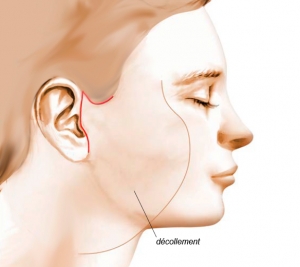
After the operation
Leaving the following day, you can a return home without a bandage after a shower and a hair wash. Your hair can be blow dried using a hair dryer on a moderate heat setting. You can also get a specialist hairdresser to assist.
If you want to go home the same day, you will have a bandage around your head, which you can remove yourself the next morning at home or come back to my clinic to have it removed.
A Minilift does not usually leave many marks on the face and any swelling (oedema) and bruising in the cervico-facial area are usually very mild. This means you can get back to your normal social life very quickly.
The stitches used will dissolve and do not need to be removed. They are placed internally under the skin’s thickness (intradermal sutures) and are invisible.
Care:
Scars should be cleaned daily with an antiseptic.
You should make a follow-up appointment 3 days after the procedure, then after 15 days, 1 month, 3 months, 6 months, and 1 year.
Recommendations:
- Exposure to the sun: no direct exposure for 1 month, then exposure is allowed with sunblock using a maximum sun protection factor.
- Make-up: the bruises can be hidden with a cover cream the day after the operation and you can apply your usual make-up over the cover cream. The products you use must be designed and suited for post-operative use. They will be prescribed to you on a post-operative prescription. However, you cannot apply any make-up directly to the scar before the 5th day but, as this is hidden by the sideburns, you will not find it troublesome.
The result
The procedure reshapes the oval of the face and neck, repositioning the cheekbone and the cheek and correcting sagging tissue. The improvement is immediately visible despite oedema (swelling) and any bruising.
On the long term, this permanently corrects tissue sagging; the majority of patients do not need another operation. In some patients, the ageing process means that another operation may be beneficial, but rarely before about fifteen years.
However, to delay the aging process, you can carry out maintenance through lighter treatments such as hyaluronic acid or Botox injections or chemical and laser peels.
The result is a relaxed, rejuvenated, expressive and natural face. Your relatives will see a change and an improvement but without being able to tell you have had a procedure.
In addition to an aesthetic improvement, this operation has a beneficial impact on the patient’s personal well-being and development.
Risks and complications
Price range
The cost of the operation will depend on the procedure to be carried out, the duration of the operation, the type of anaesthetic and any hospital charges.
If the reason for the operation is purely cosmetic, you cannot get reimbursement through a social security claim.
A detailed estimate is given to you during the first consultation according to the options you have chosen. You then have a minimum legal period of 15 days to consider your options and move your project forwards.
The first consultation costs €50. The following consultations before and after the operation are free.
The photographs on this page are here to illustrate and complete the information given on the operations. They are merely for information purposes so you can see the goals, results and scars from the operation.
The likelihood of scarring and each patient’s individual anatomy are different. Therefore, for this reason, the photographs on this site do not commit Dr. Benelli to providing all patients with a similar result.
The information given on a site is not sufficient in itself and a medical consultation is essential to get the right information for each individual case. For this, you’ll need to consult a surgeon qualified in Plastic Reconstructive and Aesthetic Surgery.
